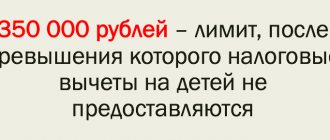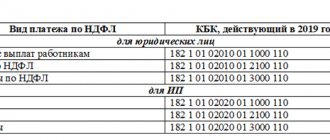Standard tax deduction is a reduction in the personal income tax withheld by a legal entity. The procedure for forming the tax base and the official conditions for receiving financial assistance from the state are established by law (Article 218 of the Tax Code of the Russian Federation). People who have the right to use the benefit include citizens providing for their own or adopted children. Among them:
- trustees,
- parents,
- adoptive parents,
- guardians.
A tax deduction of 1,400 rubles is provided by the state when people have their first children. The 3rd child and subsequent ones give the right to a more significant reduction in the calculation base for calculating personal income tax (3,000 rubles). The benefit remains until adulthood or 24 years of age, when completing full-time education. According to the current law, a disabled child of group I or II gives trustees or guardians a reason to receive financial assistance in the form of a tax deduction in the amount of 6,000 rubles. When he is supported by his parents or adoptive parents, the benefit increases to 12,000.
Limit of personal income tax deductions for children in 2021
The Tax Code of the Russian Federation contains a list of grounds on which people receive tax benefits. The law emphasizes that individuals entitled to a set of deductions are given one, the largest. The restriction does not affect children. Taxpayers receive benefits based on the number of employees. In addition, the amount doubles if the child is supported by one person.
The limitation is as follows:
- the provision of increased benefits ceases when the guardian gets married,
- to provide double the amount, a written refusal of the other parent is required, which causes difficulties during separation,
- Financial assistance is not provided if parents are deprived of their corresponding rights.
Supporting documents for “children’s” deductions
“Children’s” deductions are provided on the basis of a written application drawn up in any form and supporting documents. This is what it says in paragraph 3 of Art. 218 Tax Code of the Russian Federation. However, it is not explained which documents must be submitted. In general, this is a copy of the child’s birth certificate (letter of the Ministry of Finance of the Russian Federation dated October 2, 2015 No. 03-04-05/56445).
But in practice, as a rule, more documents are required. The exact list of documents depends on the specific situation. For example, if a child is over 18 years old and is a full-time student, then an additional certificate from the educational institution must be submitted.
If an employee has not been working at his current job since the beginning of the year, he may be required to provide a certificate of income and tax amounts from his previous place of work. This is necessary so that the current employer can check whether the maximum income level at which the application of the “children’s” deduction ceases has been reached (paragraph 2, paragraph 3, article 218 of the Tax Code of the Russian Federation, letter of the Federal Tax Service of the Russian Federation dated July 30, 2009 No. 3-5-04 /1133).
Notarization of copies of documents confirming the right to a standard personal income tax deduction is not required. The Federal Tax Service of the Russian Federation draws attention to this in letter No. ED-4-3/8418 dated May 23, 2012.
Let's consider another question related to documents: how often do you need to write an application for deduction to the accounting department?
It depends on how it was composed. If it indicated the deduction period (for example, “I ask you to provide a standard tax deduction during 2021”), then in order to receive a deduction in 2021, the employee will have to write a new application. But if the period for providing a deduction is not specified in the application and at the same time the employee’s right to a standard deduction is not terminated, then there is no need to re-fill the application. Such clarifications are given by the Ministry of Finance of the Russian Federation in letter dated May 31, 2019 No. 03-04-05/39733.
Limit of personal income tax deductions for children in 2021
Changes in the base for calculating personal income tax occur monthly until a point determined by law. The benefit is not provided when the taxpayer’s income during the year exceeds the amount established by the Russian Government. In 2016, the milestone is considered to be the income of an individual in the amount of 350,000 rubles, fixed in Art. 218 part 2 of the Tax Code of the Russian Federation.
Another limitation is the age at which the child is trained and the amount of state support. These parameters are firmly fixed. When the student turns 24 years old, the benefit ceases to apply, even if the person continues his studies. The amount of 3,000 rubles is also not subject to increase with the appearance of 5, 6 and subsequent children.
The right to state support is confirmed by a certificate from an educational institution, which must have state accreditation and issue educational documents that comply with GOST. The correspondence form does not provide this right.
Is it necessary to give two deductions at once for a disabled child?
From the text of Article 218 of the Tax Code of the Russian Federation, we can conclude that a disabled child is entitled to two “children’s” deductions at once. The first - as for any other child (1,400 rubles or 3,000 rubles, depending on the order of birth), the second - as for a disabled person (6,000 rubles or 12,000 rubles, depending on who receives). However, there is no direct answer to the question of whether it is necessary to give both deductions at the same time.
Specialists from the Ministry of Finance of Russia agree with this position (letter dated November 7, 2019 No. 03-04-05/85821; see “One of the children in the family is disabled: how to calculate the standard deduction for personal income tax?”).
The judges are of the same opinion. The review released by the Presidium of the Supreme Court of the Russian Federation on October 21, 2015 states that the amount of deductions for a disabled child is being added (read more about this in the article “The Supreme Court of the Russian Federation summarized the practice on disputes about personal income tax: what court conclusions should accountants and employees know about” ). This means that if a child with a disability is, for example, the second in the family, then his parent has the right to receive a monthly deduction in the amount of 13,400 rubles (1,400 + 12,000).
An example of calculating the tax deduction for children
For clarity, the following initial data is offered: a mother is a citizen receiving an official salary of 70,000 rubles, and five children aged 21, 17, 13, 11 and 3 years. Having studied the current legislation, she submits a corresponding application to the employer. It states that the youngest and second son are entitled to a deduction in the amount of 2,800 rubles, the 3rd and 4th - 6,000, the eldest - a full-time student - also 3,000. The total amount is 11,800 rubles / month.
Next, this figure is deducted from the salary of a mother with many children until May, because during this period her income exceeds 350,000 rubles. Every month from January to May, personal income tax will be calculated using the formula: personal income tax = (70,000 - 11.8 thousand) x 13% = 7,566, and the woman will receive 62,434 rubles in her hands.
The difference is that without an application, a legal entity calculates personal income tax differently: 70 thousand x 13% = 9,100, and the employee’s net income would be 60,800, which is less by 1,634 rubles per month and 8,170 per year, taking into account the termination of state support in May.
Who is entitled to a deduction and in what amount?
The child deduction is a standard deduction, and paragraph 1 of Article 218 of the Tax Code of the Russian Federation is devoted to it.
The “children’s” deduction is due to the following persons who support the child: a parent (including an adopted one), his or her spouse, an adoptive parent, a guardian and a trustee. Calculate your salary and personal income tax with standard deductions for free in the web service
The “children’s” deduction is provided for all children, without exception, under the age of 18, as well as for full-time students, graduate students, residents, interns, students and cadets under the age of 24. The amount of the deduction depends on the type of child in the family. For the first and second child, the deduction amount is 1,400 rubles each. per month. For the third and each subsequent child - 3,000 rubles. per month. When establishing the priority, it is necessary to take into account children from previous marriages, if they live in a new family, or alimony is transferred to them (see “When providing a “children’s” deduction, the total number of children, including the children of the spouse from the first marriage”). Let us add that the indicated deduction values are the same for everyone who is entitled to them. Comments on some “atypical” situations are given in Table 1.
Table 1
Explanations from officials on “children’s” deductions in unusual situations
| Situation | Comment from the Russian Ministry of Finance |
| The father has a child from his first marriage who is over 18 years old and lives with his mother | When determining the total number of children, a child from his first marriage is taken into account by the father, but not taken into account by his new wife (letter dated January 21, 2016 No. 03-04-05/1999) |
| Husband pays child support from first marriage | The current spouse has the right to receive a deduction for this child (letter dated 03/18/15 No. 03-04-05/14392) |
| The deduction for the first and second child is not provided due to their age | The deduction for the third child is 3,000 rubles. (letter dated 04/17/14 No. 03-04-05/17619) |
| A full-time student under the age of 24 got married | The parent loses the right to deduction (letter dated 03/31/14 No. 03-04-06/14217) |
| The child is registered at an address different from the parents' address | The right to deduction remains (letter dated 05/11/12 No. 03-04-05/8-629) |
| Twins were born into the family | Their order can be determined in any order (letter dated 12/21/11 No. 03-04-05/8-1075) |
| The wife's children from her first marriage live with their mother and her new husband, who did not adopt them | The current husband has the right to receive a deduction for these children (letter dated 09/05/12 No. 03-04-05/8-1064) |
In addition, a separate deduction is provided for a disabled child. It is provided for children with disabilities under the age of 18. It is also provided for full-time students, graduate students, residents, interns and students under the age of 24, if they are disabled people of group I or II. The size of the deduction depends on who receives it. If this is a parent, his spouse, or an adoptive parent, then the deduction is 12,000 rubles. per month for one child. For an adoptive parent, his or her spouse, caregiver and guardian, the deduction is RUB 6,000. per month.
Documents for obtaining a tax deduction for children
There are two ways to take advantage of the benefit:
- Application to the employer.
- 3-NDFL to the Federal Tax Service at the place of primary residence.
In the first case, the taxpayer receives financial assistance from the state during the tax period. The declaration is submitted when benefits were not provided for some reason.
Statement
At the same time, photocopies of the accompanying documents are submitted:
- birth or adoption certificate,
- spouses' passports, marriage document.
If available, served:
- document from educational institution,
- a certificate from a medical institution about the child’s condition.
If the employee is the only applicant, the following must be submitted:
- death certificate of husband (wife),
- passport,
- birth document drawn up according to the mother's words,
- a court decision declaring a person missing.
When the applicant is a guardian, attach:
- foster family agreement
- appropriate confirmation from the guardianship authorities.
Declaration
Along with 3-NDFL, the following is submitted to the Federal Tax Service:
- 2-NDFL from the tax agent’s accounting department,
- documents confirming the right to benefits,
- application on the form of the Federal Tax Service.
With the development of technology, the need to personally contact government employees has disappeared. Documents are submitted remotely, starting with first obtaining access to your personal account on the website of the Federal Tax Service. Having provided the necessary documents with payment details, the applicant awaits their verification and crediting of funds. You can find out about the results of the work done in your personal account or in a letter that the tax officer must send to the applicant after completing all bureaucratic procedures.
For what period should the “children’s” deduction be provided?
The Tax Code clearly states that “children’s” deductions are provided up to the month in which the employee’s income, calculated cumulatively from the beginning of the year, exceeded 350,000 rubles. Please note that income does not include dividends, as well as payments exempt from personal income tax (letter of the Ministry of Finance of Russia dated March 21, 2013 No. 03-04-06/8872, see “When determining the maximum amount of income in respect of which a child deduction is granted , payments exempt from personal income tax are not taken into account"). Also, daily allowances, amounts of financial assistance and additional contributions to a funded pension are not taken into account (letter of the Federal Tax Service dated 08/09/19 No. SD-4-11 / [email protected] ; see “Standard deductions for personal income tax “for children”: are daily allowances and financial assistance taken into account when calculating the employee’s income limit?”).
Starting from the month in which the milestone is 350,000 rubles. passed, deductions for the child are canceled.
Let's give an example. Let’s say the monthly salary of an employee with children is 55,000 rubles. Then in the first half of the year his income will be equal to 330,000 rubles (55,000 rubles × 6 months). This means that in the period from January to June inclusive, the accountant will provide him with “children’s” deductions. In July, income will reach 385,000 rubles (55,000 rubles × 7 months). Therefore, in July and subsequent months of the year, deductions for children will not be provided.
Another reason for canceling the deduction is when the child reaches the age of 18. For older children in full-time education, there are two reasons: either completing their studies or reaching the age of 24. Experts from the Ministry of Finance explained: the right to deduction remains until the end of the year in which the child turns 18 years old. For full-time students, the same rule sounds like this: the right to deduction remains until the end of the year in which the child turns 24 years old, if training has not yet been completed. As soon as studies are completed, regardless of age, deductions stop (letter dated October 22, 2014 No. 03-04-05/53291; “The Ministry of Finance explained for what period the standard personal income tax deduction for children is provided”).
The question may also arise: for what period should a child deduction be provided if the employee applies for it in the middle of the year? Simply put, is it necessary to give a deduction for January and February if the employee applied for a deduction in March? The answer is contained in Article 218 of the Tax Code of the Russian Federation. It says that the deduction is due from the month of birth of the child, or from the month in which the adoption took place, guardianship (trusteeship) was established, or the child was placed in foster care. There are no additional conditions regarding the moment of applying for a deduction in the Code. Therefore, in case of a late application, the accountant must give a deduction retroactively. The Federal Tax Service for Moscow also agrees with this approach (letter dated December 26, 2017 No. 20-15 / [email protected] ; “Standard deduction for a child: what documents should an employee provide?”).
Subtraction leads to multiplication
Working parents with disabled children of group I or II under 18 years of age will receive an impressive deduction for personal income tax (NDFL) from January 1, 2021.
The deduction has been increased fourfold this year, from three thousand rubles to twelve. The same benefit applies to parents of disabled children of group I or II under 24 years of age who are still studying (students, graduate students, residents). And guardians, trustees, adoptive parents and their spouses who support such children will be given a deduction in the amount of 6,000 rubles. From these amounts you will be returned 13 percent - the amount of personal income tax.
The deduction of 1,400 rubles for the first and second child and 3,000 rubles for all subsequent children in the family remains the same. At the same time, the annual income ceiling at which deductions are granted will increase from the current 280 thousand rubles to 350 thousand rubles. That is, more families will be able to receive it. For example, with a salary of 20 thousand rubles per month, a lesser amount of tax will be withheld from an employee raising a disabled child, and he will receive 1,170 rubles more in hand than in 2015.
In order to claim your right to deductions, you need to contact the accounting department of the company where you work. Or, at the end of the tax year, fill out the 3-NDFL income declaration yourself and send it to your tax office. When filling out the declaration, there is a special column in the “tax deductions” section.
Until this year, employees claiming social tax deductions for treatment and training could return the personal income tax amount only to the tax office, and at the end of the tax year. From 2021 there is no need to wait for the end of the year. Deductions can be obtained from the employer. To do this, you should contact the accounting department with a written application and submit a notice issued by the tax office to confirm your right to receive social tax deductions. Deductions will begin exactly the month in which you report them to the accounting department.
If, after receiving your application at your place of work, the accounting department withheld tax without taking into account social tax deductions, then it will still be required to return this amount. The notification form was approved by order of the Federal Tax Service and is available on the website www.nalog.ru
Income that is not subject to personal income tax from 2021
The cost of legal expenses incurred by citizens during the consideration of their cases in the courts and then reimbursed by decision of the courts is exempt from income tax, the Federal Tax Service told RG;
as well as income in the form of the value of property (property rights) received by the taxpayer-shareholder (participant, shareholder, founder) during the liquidation of a foreign organization.
What investment tax deductions can you get as early as 2016?
Rossiyskaya Gazeta addressed this question to the Federal Tax Service.
In 2015, the Tax Code was supplemented with the article “Investment tax deductions,” the Federal Tax Service informed us.
This benefit is given to stimulate the investment activities of individuals making long-term financial investments in securities.
There are three different types of such tax deductions.
Firstly, in the amount of the positive financial result from the sale (redemption) of securities that were owned by the taxpayer for more than three years.
Secondly, in the amount of funds deposited by the taxpayer into an individual investment account (IIA).
Thirdly, in the amount of income received from transactions recorded on an individual investment account.
Only taxpayers who have deposited their funds into an individual investment account will be able to take advantage of the right to receive investment tax deductions in 2021.
Sellers of securities will be able to receive a tax deduction on their tax return starting in 2021. A tax deduction in the amount of income from transactions accounted for on an individual investment account will be provided by tax agents when calculating tax amounts starting in 2021, or by tax authorities from 2019 when citizens submit personal income tax returns.
For example, you invested 100 thousand rubles in an investment account in bonds, which brought you 10 percent of income. This is 10 thousand rubles, from which you can receive a 13 percent investment deduction (1,300 rubles).
The total income will be: 11.3 thousand, or 11.3 percent.
Now how and where to open an individual investment account? In the bank. This is a special type of brokerage account. It can only be opened by a Russian citizen. And have only one account through which investment tax deductions are received.
Infographics: Leonid Kuleshov / Elena Berezina








